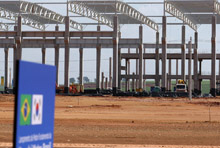
Typical street scene in Santa Ana, El Salvador. (Photo: iStock)
IMF Survey: Global Capital Flows in Spotlight at Brazil Conference
May 26, 2011
- Multibillion-dollar flows can potentially make countries vulnerable
- Rio conference looks at ways to manage capital flows, maintain stability
- IMF listening to countries' views, considering best policy responses
With emerging markets around the world showing strong growth and attracting large inflows of capital, key policymakers, academics, and private sector participants met in Brazil to discuss how to manage the potentially destabilizing wave of money.

Korean auto plant construction in Piracicaba, Brazil, where portfolio flows, foreign investment totaled $100 billion in 2010 (photo: Ernesto Rodrigues/AE)
RIO DE JANEIRO CONFERENCE
Min Zhu, Special Advisor to the IMF’s Managing Director, said in opening remarks at the May 26 event that countries had a variety of policy options and tools to manage capital flows that can sometimes amount to billions of dollars a year.
The IMF started reexamining these issues soon after flows to emerging market economies began to rebound from the global crisis, preparing research and analysis that looked in detail at how to use the policy toolkit available to countries, including capital controls. This provided the analytical backing to a framework that was discussed with member countries earlier this year and that will guide IMF policy advice in this area.
Overall, the basic ideas are grounded in key principles: policy interventions should be as closely aligned to the problem at hand as possible, and each country needs to take into account the spillovers and multilateral consequences of its actions.
Macro first
In order to reap the benefits of capital inflows, Min Zhu encouraged countries to first focus on macroeconomic policy and structural measures that improve the functioning and resilience of financial sectors, and thereby help to mitigate the macro and financial-stability risks that surges in inflows may bring.
• Allowing the exchange rate to appreciate unless it is overvalued and/or external stability is at risk;
• Accumulating reserves in line with country insurance metrics;
• Adjusting the monetary/fiscal policy mix by tightening fiscal policy to maintain a sustainable pace of demand growth and, if conditions permit, lowering policy interest rates; and
• Strengthening the macroprudential framework to ensure that financial-stability risks are contained.
Blessing or curse?
The conference was opened over lunch by Brazil’s Finance Minister, Guido Mantega. Brazil’s central bank governor, Alexandre Tombini, and the IMF’s Min Zhu provided introductory remarks before delegates examined the causes of the recent wave of inflows to emerging markets in the wake of the global economic crisis, and whether they are a blessing or a curse. Policy responses to capital inflows were discussed as were regional perspectives on these issues.
Capital flows to emerging markets rebounded after a sharp decline during the global financial crisis and are projected to remain high, although volatile, in the coming years. These flows, and capital mobility more generally, allow countries with limited savings to attract financing for productive investment projects, foster the diversification of investment risk, and contribute to the development of financial markets.
Since the financial crisis, many emerging market countries are also concerned about the fragility that large inflows—and herd behavior that contributes to boom-bust cycles—can engender.
Tailored response
Zhu said that any response should be tailored to the circumstances of each country. In Latin America, big inflows of capital could increase the region’s vulnerabilities. For example, Brazil received $100 billion in portfolio flows and foreign direct investment in 2010 and a further $37 billion in the first quarter of this year.
Because the region’s capital accounts tend to be relatively more open, they are often subject to larger swings in capital flows. The region has been enjoying not only easy financing conditions but also high terms of trade because of strong commodity exports, creating issues of overheating and of managing good times to avoid a boom-bust cycle.
Other side of the coin
The IMF is also looking at the other side of the coin—the source of capital and policies in these capital-exporting countries. IMF staff are undertaking in-depth analysis of the outward spillovers, through capital flows and otherwise, from the five largest economies in the world—China, the euro area, Japan, the United Kingdom, and the United States. The findings will be presented in a series of Spillover Reports, to be discussed by the IMF’s Executive Board, alongside each country’s regular Article IV surveillance report, this July.
The IMF has been reexamining the appropriate policy responses to capital flows and recently published a series of papers on the controversial issue.


